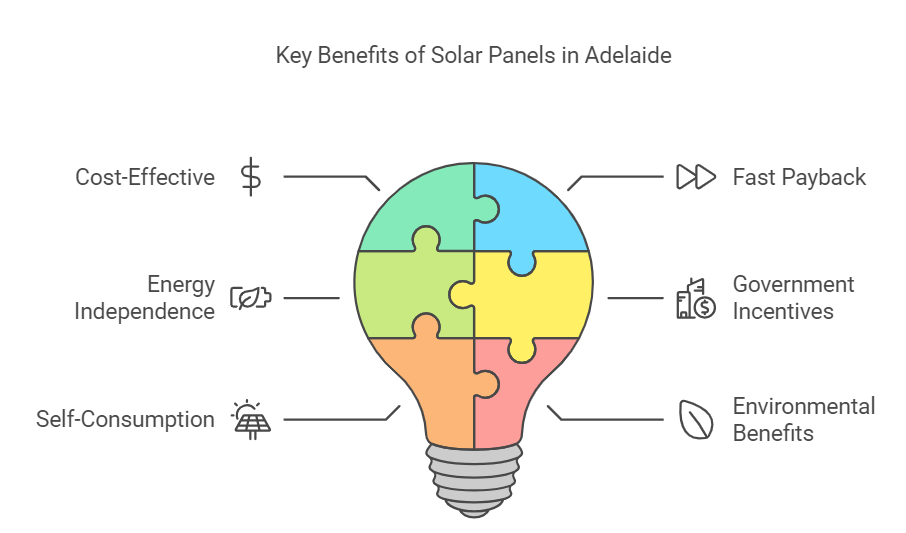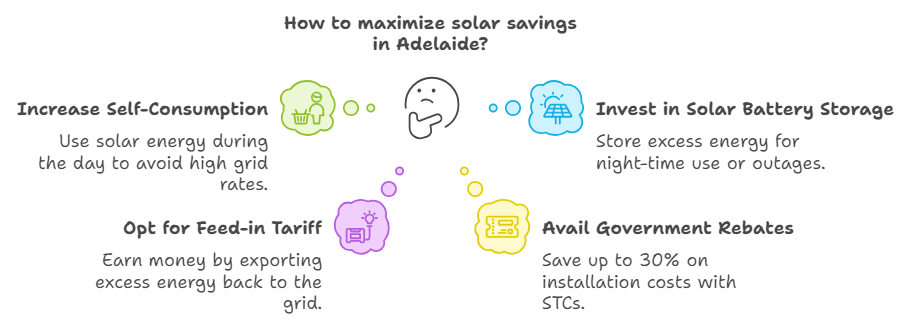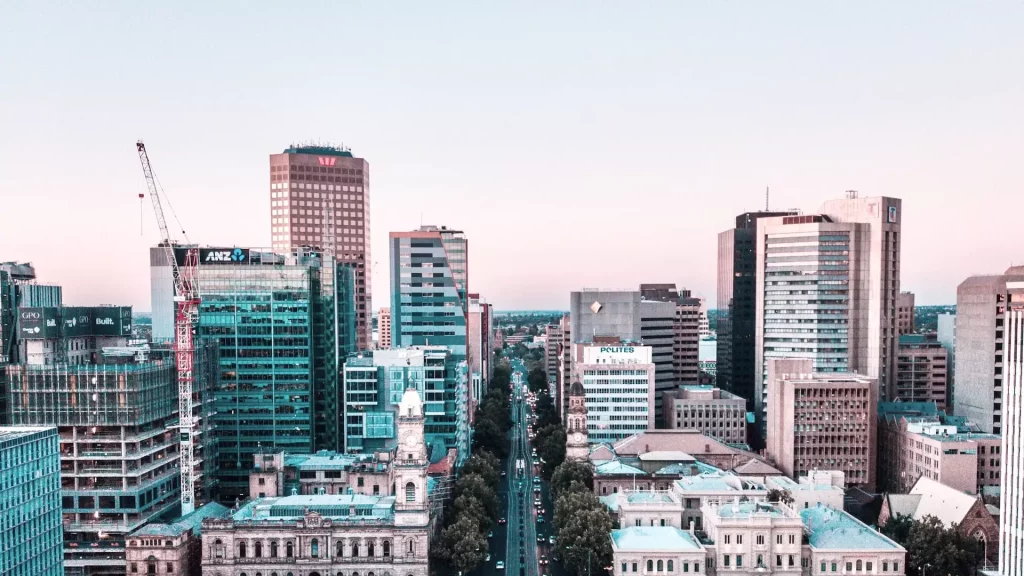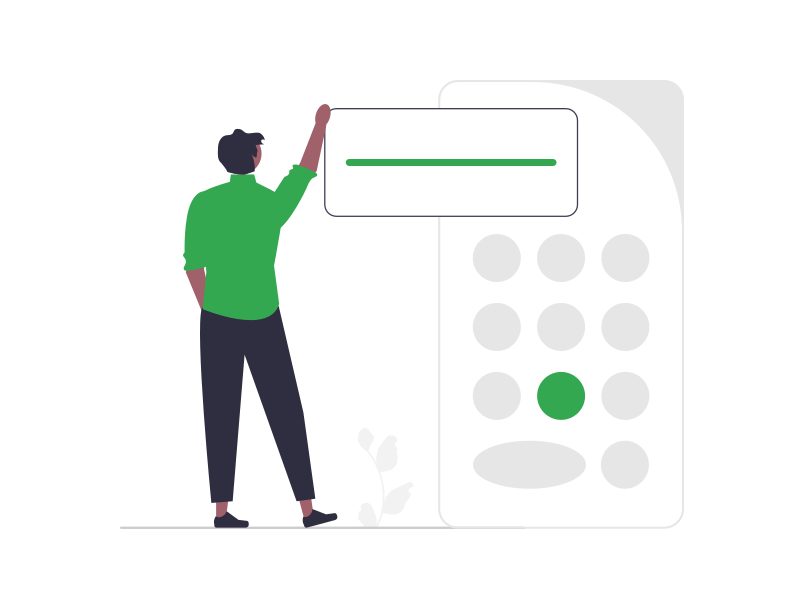At Solar Choice, we’ve pre-vetted a network of over 300 trusted installers across Australia, including many based right here in Adelaide. By choosing local installers in South Australia, you’re supporting local businesses and ensuring your solar system is optimised for Adelaide’s unique conditions.
Solar panels Adelaide – key takeaways
- A typical 6.6 kW solar system in Adelaide costs around $4,730, after government rebates are applied.
- The average payback period for solar panel installations in Adelaide ranges from 3.4 to 3.9 years, making it a financially sound investment.
- Government incentives in South Australia, including Small-scale Technology Certificates (STCs), can cover up to 30% of the system cost.
- Self-consumption of solar energy is the primary way to save money, with feed-in tariffs providing additional benefits.
- Battery storage systems, supported by the City of Adelaide’s battery rebate, are becoming more attractive, especially for households and businesses looking for energy independence and protection from power outages.
- Most homes in Adelaide are suitable for solar installations, with 6.6 kW systems (typically requiring 16-20 panels) being the most popular size.
- Adelaide’s sunshine hours (around 5.5 peak sun hours per day) make it an ideal city for solar energy production.
Ready to compare solar & battery quotes?
Since 2008 our knowledge and sophisticated software have allowed over 160,000 Australian households and businesses to make a well-informed choice on their solar & battery installer.
How much power do solar panels produce in Adelaide?
The table below provides an overview of how much energy you can expect some common residential solar system sizes to generate, assuming that they are north-facing and about 75% efficient (a conservative number). Please note that these numbers are averages – actual energy yields will be higher in summer and lower in winter.
Estimated Solar PV system energy yields for solar panels Adelaide | ||
| Solar system size (kilowatts) | Avg daily system output (kilowatt-hours) | Annual output (kilowatt-hours) |
| 3kW | 10.9 kWh | 3,978 kWh |
| 4kW | 14.4 kWh | 5,256 kWh |
| 5kW | 18.2 kWh | 6643 kWh |
| 7kW | 24.5 kWh | 8943 kWh |
| 10kW* | 36.3 kWh | 13250 kWh |
*Note: Solar systems on single-phase connections in South Australia are limited to 5kW of exports. Some areas with congested grids are lower at 1.5kW.
What do these energy output numbers mean for my home? (and how much solar do I need?)
The numbers in the table above show you how much energy your solar system is likely to produce, but to work out how much you’ll save with a South Australian solar system you need to estimate how much of the solar energy you’re likely to consume directly as opposed to ‘exporting’ into the grid.
To find the right size system for your home, you will need to consider how much roof space you have available, what your budget for a system is, and how many solar panels a South Australian Power Networks will allow you to install. We encourage you to play with the numbers yourself using our Solar System Payback & ROI Estimator tool.
How do you benefit from solar panels in Adelaide?

There are some key ways in which homeowners benefits from solar panel installations. It is important to understand these so that you can make an assessment of whether solar panels will be worth it in your circumstances.
Solar Self Consumption
Solar self consumption is the process of your home using solar power instead of pulling power from the grid. This reduces the amount of power (kilowatt-hours) you have to buy from your electricity retailer. Given these rates are quite high in Adelaide – this is primary way in which you will benefit from your solar panels.
Selling energy back to the grid
If you are generating more solar power than you need in your home, the surplus power can be sold back to your electricity retailer. There is no regulations in South Australia around what rate the retailer need to give you for your excess solar power and these rates have been falling in recent years. While the best bonus feed in rates can be 10 cents to 12 cents per kWh typically these rates for the best overall electricity plan in Adelaide can be around 3 cents to 8 cents per kWh.
Environmental Benefits
Installing solar power will increase your energy independence and reduce your reliance on the grid which is supported by fossil fuels. As a result solar panels reduce your household carbon footprint and contribute towards Australia’s transition off fossil fuel energy generation.
These benefits contribute to a financially and environmentally attractive upgrade for your home. Along with the main benefits discussed above, solar panels also have long life expectancy with 25 year+ warranties and are eligible for state and federal rebates.
Solar Choice has been independently educating solar consumers since 2008. You can use our online portal to compare quotes from local installers that we have pre-vetted.
Compare quotes from up to 7 installers in your area now.
Incentives and rebates for solar power in Adelaide
Up-front ‘discounts’ on solar system installation prices via federal Renewable Energy Target
The federal government offers up-front incentives in the form of ‘small-scale technology certificates’ (STCs). STCs significantly reduce the cost of having a solar PV system installed – typically by around 30% of the total system cost. This incentive should be automatically applied to the price of your system by your installer – you won’t have to take any action yourself to claim it.
The City of Adelaide’s rebates for solar PV & energy storage
If you’re wondering what the current solar rebate in SA is then The City of Adelaide offers a generous rebate for solar PV and solar battery storage systems installed in the 5000 and 5006 postcodes which meet certain eligibility criteria. You can read more about this scheme here: The City of Adelaide’s Sustainability Incentive Scheme.
Feed-in tariffs in South Australia
The rate you are paid for your excess solar energy is generally referred to as a ‘feed-in tariff’. At present in South Australia, the rate you are paid depends on your electricity retailer and the plan you are on – you can utlise this electricity plan comparison tool to compare current offerings.
Remember, homes with solar panels save money by consuming solar power as it is generated. This way, you don’t need to buy electricity from the power companies. Making the solar energy you use just as valuable as the electricity you would otherwise buy.
How Much Do Solar Panels Cost in Adelaide? (March 2025)
Australian solar system installation prices are among the lowest in the world – we know this because we’ve been keeping track for a few years now with our monthly Solar PV Price Index. The price of solar has declined significantly over recent years as the production scale in Asia has increased dramatically. We are now seeing a more competitive environment for solar installs in Australia keeping profit margins slim.
Based on our data from March 2025, a typical 6kW solar system would cost $5,510 on average in Adelaide, including the STC rebate and GST.
The table below shows the average cost of solar panel installations in Adelaide after Solar System Size, after government rebates.
| Solar System Size | Average Cost in Adelaide (2025) |
|---|---|
| 3kW | $3,810 |
| 4kW | $4,080 |
| 5kW | $4,570 |
| 6kW | $4,960 |
| 7kW | $5,800 |
| 10kW | $7,770 |
Premium Solar Panel Costs (March 2025)
For higher-quality solar systems, expect to pay 20-30% more for premium components. Here’s a breakdown of premium solar panel pricing in Adelaide.
| Solar System Size | Premium System Cost (2025) |
| 3kW | $5,030 |
| 4kW | $5,440 |
| 5kW | $5,930 |
| 6kW | $6,580 |
| 7kW | $7,670 |
| 10kW | $10,350 |
You will see in the below graph the history of solar prices in Australia, published monthly by Solar Choice. Adelaide pricing, in orange, has tracked closely to the national average, with spikes triggered by state incentive schemes and other announcements.
Compare quotes from up to 7 installers in your area now.
What is the financial return for solar in Adelaide?
As the table below illustrates, payback times for solar systems in Adelaide can be quite short and savings quite large.
We just urge that you make sure that the system you’re purchasing uses quality components and is installed by a reputable installer. Lower prices don’t always indicate lower quality, but they should be approached with a healthy degree of caution – remember that a solar system should last up to 25 years (with inverter replacements every 7-10 years). Any system downtime will reduce savings and extend the payback period – not to mention costs incurred for any repairs not covered by the system’s warranty.
Indicative Returns for solar panels Adelaide– Updated March 2025 – |
|||||
| Solar Panel Size | Average Cost | Average Daily Energy Usage | Self Consumption Rate | Annual Savings | Payback Period |
| 5kW | $4,800 | 15 kWh | 40% | $1,195 | 4.0 Years |
| 6.6kW | $4,730 | 20 kWh | 40% | $1,525 | 3.1 Years |
| 10kW | $9,140 | 30 kWh | 40% | $2,389 | 3.8 Years |
| 15kW | $14,355 | 45 kWh | 40% | $3,663 | 3.9 Years |
Assumptions/Limitations
- Assumes an energy price of 38.4c / kWh which is towards the middle of what is offered in Adelaide
- Assumes a solar feed-in tariff of 7c / kWh
- Average costs come from the Solar Choice Price Index for March 2025
- Your self-consumption rate will vary depending on how you use power in your home. At higher rate, means less power is exported to the grid and improves your financial return
Adelaide Solar System Payback & ROI Calculator
What about home battery storage in Adelaide?
South Australia has one of Australia’s most attractive state-based solar battery rebate schemes, which for example can deduct $2,700 from the cost of a Tesla Powerwall 3. The SA solar battery rebate is scaled based on the size (kWh rating) of the battery.
With frequent power outages and fluctuating feed-in tariffs in South Australia, battery storage offers significant benefits that are not just financial. By storing excess solar energy, you can reduce your reliance on the grid and avoid blackouts
In our regularly updating analysis on ‘whether solar batteries are worth it‘ we have suggested that the economics don’t quite stack up for solar batteries in South Australia just yet (despite the attractive SA Solar rebate) when looking at it as a purely financial decision:
System |
Cost |
Annual Savings |
IRR |
Payback |
| 6.6kW Solar & 10kWh battery |
$17,340 (total) Breakdown: $5,510 (solar) $12,400 (battery) |
$2,653 (total) Breakdown: $1,453 (solar) $945 (battery) $254 (feed-in) |
16.9% (total) Breakdown: 26% (solar) 8% (battery) |
7 years (total) Breakdown: 4 years (solar) 12 years (battery) |
Assumptions
- Flat electricity rate of 38.4 cents per kWh and a feed-in tariff of 7 cents per kWh
- Solar and battery pricing in Adelaide from Solar Choice Price Index and Battery Price Index
- Electricity usage of 30kWh a day with load profile is double-peak in morning and evening
- Energy price inflation at 3% and future cash flow discount rate of 5%
For a full explanation of our methodology and assumptions – see the full article.
For this reason, many Adelaide customers are installing solar only, however keeping their options open to add a solar battery in the future if prices come down. Installing a ‘hybrid’ inverter with your solar system will increase your options when adding a battery as you can DC-couple a battery without the need for an additional inverter.

How to find the best solar company in Adelaide?
Before selecting your installer, be sure to review our 5 essential questions to ask your solar installer. These will help ensure you choose a reputable provider for your solar installation.
We’ve helped thousands of Adelaide residents and businesses make the switch to solar. For example, Adelaide Image Printing installed a 40kW solar system with our guidance, reducing their energy costs significantly.
Since 2008, Solar Choice has been a trusted solar quote comparison service for the Adelaide region. With deep local knowledge and strong partnerships with Adelaide-based solar installers. Let our experience guide you to the best solar choice for your needs.
Compare quotes from up to 7 pre-vetted installers in your area now.
Since 2008 our knowledge and sophisticated software has allowed over 160,000 Australian households and businesses to make a well-informed choice on their solar & battery installer.
Looking for Commercial Solar Installation in Adelaide?
Commercial solar installations in Adelaide can provide businesses with significant cost savings and environmental benefits. Solar Choice offers free, no-obligation South Australian Solar Business Case whereby you can explore commercial solar options and see how your business can benefit from solar power. Explore our guide to Commercial Solar Adelaide: Understanding your options
Frequently Asked Questions
How many homes in Adelaide have solar panels?
How much does a solar system cost in Adelaide (March 2025)?
What government incentives are available for solar panels in Adelaide?
What is the best direction for solar panels in Adelaide?
How much energy can a solar system generate in Adelaide?
Is battery storage worth it in Adelaide?
How much can I save with solar in Adelaide?
What size solar system do I need for my home?
How do I find the best solar installer in Adelaide?
Can I install more than 5 kW of solar on a single-phase connection?
What should I ask my solar installer before signing a contract?
- Solar Panel Costs: Solar Choice Price Index | April 2025 - 1 April, 2025
- Solar Panels For Homes – All You Need to Know About Solar Systems - 18 March, 2025
- Best NSW Solar Feed-In Tariffs - 17 March, 2025


HI,
I want to get a system with batteries on a granny flat, but not connected to the grid. Is that possible??
Hi Maria,
Yes it is possible to connect a granny flat to an off-grid solar system with a battery. In some cases this might be a more cost effective option of running sub-mains from your main switchboard.
You can learn more about off-grid systems here – https://www.solarchoice.net.au/blog/is-an-off-grid-solar-system-worth-it/
Cheers
Solar Choice
Please clear up a use of Solar power for me. You say that the best way to use it, is as it produced. It is my understanding that with the current smart meters all solar power produced is sent to the grid and on todays rate I get 6.5c per Kwh. Likewise all power I use is charged at the current SA power user rate of 31c per Kwh (approx). So based on this, what difference does it make when you use power – if it was a reversing meter I could understand, but when all solar produce power goes to the grid I am at a loss. Please help a confused customer.
Hi Bill,
Think about it this way – when you run devices in your home, they’ll first use the power that’s being produced locally (i.e. the solar panels). If there’s not enough energy from the solar panels, you automatically draw from the grid (and pay for it). Likewise, if there’s not enough electricity usage to ‘soak up’ the energy produced by your panels, it ‘leaks’ back into the grid. Most homes use more energy at night, but it’s possible to shift the usage of certain devices (e.g. a washing machine or dishwasher) to daylight hours to use up more solar energy.
The main thing to understand is that the solar energy is not automatically sent back into the grid – only the excess is. By using the solar energy yourself, there’s less energy that you have to purchase from the grid at 31c/kWh.
Hope that makes some kind of sense. You can also read our article about solar self-consumption here.
Hello
We have 14 Bosch panels which have been good for four years. However, there has been a clear fall-off of power over the last year or so. This is about 15% less, or worse. (Its not dirt or trees – the panels face NW at 40 deg, and get cleaned at intervals).
Its not one bad panel, as blocking each in turn cuts power similarly.
Bosch say, “Sounds valid, get them checked by an installer and we will replace and pay costs if there is a deficit”.
Can you help? And if so, in what way?
Thanx
Hi Malc,
Thank you for your comment. Over time there will be a slight loss of efficiency but this does sound a little higher than normal. It will be best to contact a solar accredited electrician in your area to come and test the system. They will also be able to find any faults or problems with the panels. Simply search solar accredited electrician followed by your post code and a list will show in the yellow and white pages
Hi, have purchased a new house, which has existing solar panels on the roof. No nothing about solar. Do I need to negotiate a contract with my existing electricity supplier? Do I receive a tariff? Who would I contact to enquire about battery storage? Dont move in for another month, but system is approx 18 panels/4.5kW. Postcode 5118. Thanks in advance.
Hi Dave,
Recognising that our response has taken quite some time (we get lots of comments on our blog), but the basic answer to your question is that you need to shop around for a different energy retailer to get a better overall deal.
For your reference, we keep a list of feed-in tariff rates by state and retailer here. Also check out the government’s EnergyMadeEasy website to compare deals more holistically, or our own Solar-Friendly Electricity Plan Comparison Tool.
Hope this helps.
Hello. Can you help?? I am purchasing a house which has a 18 year contract for 5 kW solar power system on it. It is 3 years into the contract according to the owners who advised me that I now get that benefit for the next 15 years at the same contracted price of 24 cents per kw as I am taking over the property and contract now. I can find it in any current legislation that this is the case. I saw it was on your page from 2011 however. So just want to know where I stand as when I rang the company they said I am legible for 5 cents :( ??
Sorry can’t see it in legislation. And can’t find out more cos I am not the policy holder etx
Hi Shane,
By contract, are you referring to a contract for a solar feed-in tariff, or a power purchase / solar lease agreement?
I’m going to assume that you’re talking about the feed-in tariff rate. In South Australia the benefits do appear to be transferable to those who purchase a home with solar panels on an existing solar feed-in tariff arrangement. You can read a bit more about this in our article ‘When do the feed-in tariffs end?‘; you can also see where it is addressed directly on SA.GOV.AU’s FAQ page about the state’s feed-in tariff.
Hope this clears things up for you! Fortunately it sounds like you’ll be receiving the higher rate!